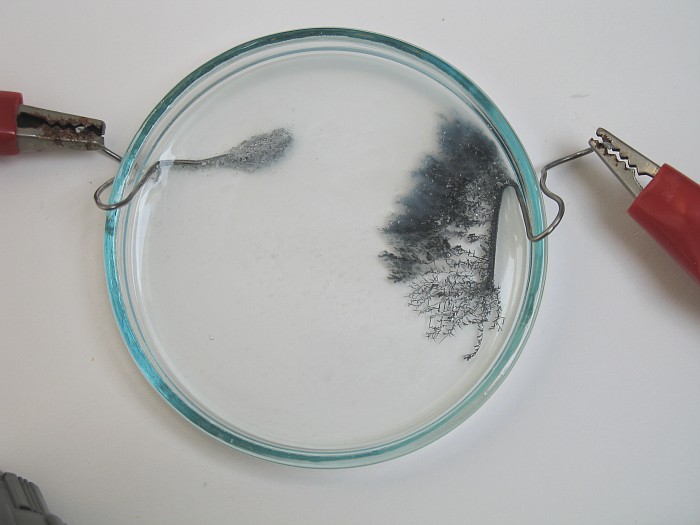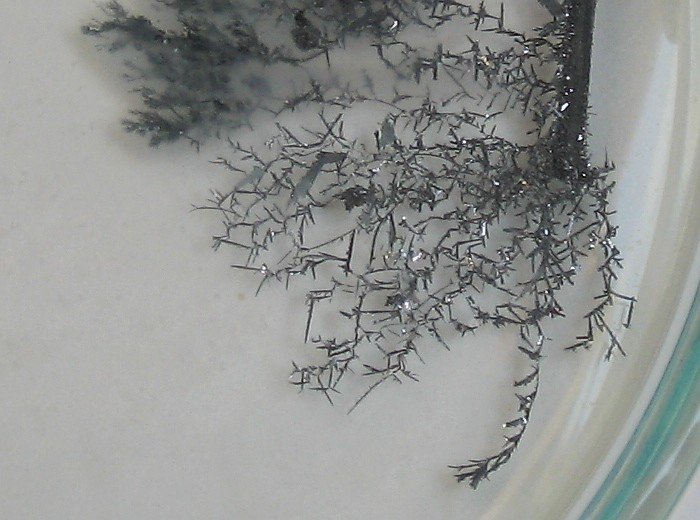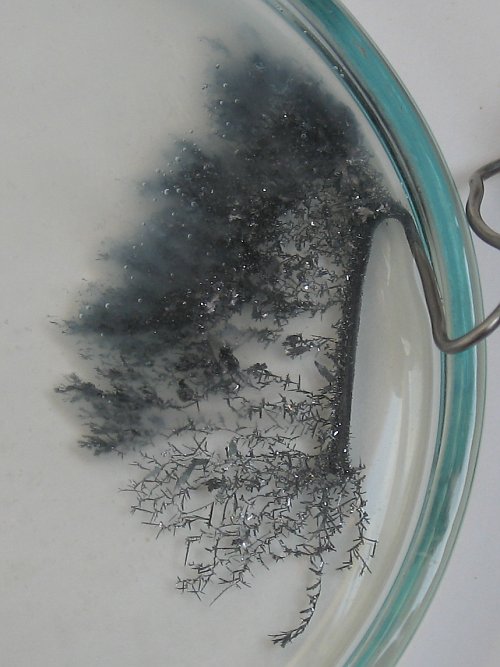


Lead crystals by means of electrolysis
When a lead salt is electrolysed, then beautiful shiny lead crystals are formed. These crystals are formed at the cathode. The lead does not plate out on the cathode, but forms needle-shaped crystals, which grow towards the anode.
![]()
![]() Required
chemicals:
Required
chemicals:
-
lead nitrate
![]() Required
equipment:
Required
equipment:
-
power supply (12 to 15 V DC)
-
soldering wire (Pb/Sn, or even better Pb only)
![]() Safety:
Safety:
- Lead salts, including lead nitrate, are very toxic and besides this, lead is a cumulative poison, so be absolutely sure that you are not exposed to the lead salts.
- Do not leave the electrolysis process unattended for a long time. The metal crystals grow from cathode to anode and in the long run, a short-circuit may be produced.
![]() Disposal:
Disposal:
- The waste should not be flushed down the drain. Collect the waste and bring it to a proper waste processing facility.
![]()
Procedure for performing the experiment
![]() Dissolve
a spatula full of lead nitrate in a few ml of water and put this solution in a
petri dish with a diameter of approximately 8 cm.
Dissolve
a spatula full of lead nitrate in a few ml of water and put this solution in a
petri dish with a diameter of approximately 8 cm.
![]() Add more water, such that the petri dish is filled with a
layer of 3 to 4 mm of solution.
Add more water, such that the petri dish is filled with a
layer of 3 to 4 mm of solution.
![]() Put a
set of electrodes in the petri dish. Use soldering wire for easy bending. This
may require some bending and tweaking the position such that the wires are not
pushed out of the solution. Connect the wires to two clamps and connect these to
a power supply.
Put a
set of electrodes in the petri dish. Use soldering wire for easy bending. This
may require some bending and tweaking the position such that the wires are not
pushed out of the solution. Connect the wires to two clamps and connect these to
a power supply.
![]() Switch
on the power supply and see what happens. Use a DC power supply of 12 to 15
volts.
Switch
on the power supply and see what happens. Use a DC power supply of 12 to 15
volts.
![]()
Result of the experiment
In a time frame of approximately 10 minutes, a nice structure, consisting of needle-like shiny crystals is formed at the cathode. The anode, also made of soldering wire, slowly dissolves and a kind of mud/dirt is produced at this, and this mud also slowly migrates towards the anode.
After 10 minutes, the result is as follows:

At the left one can see the anode, which has a lot of mud around it. At the right one can see the cathode with a nice crystalline structure. Unfortunately, at the top part, the structure is damaged by material, coming from the anode.
A close-up of the crystal structure nicely shows its structure:

The material from the anode has a strong influence on what is produced at the cathode. At the place, where the material from the anode arrives, no longer a nice crystalline structure is formed, but a denser, more sponge-like structure is formed, with formation of bubbles of gas (most likely hydrogen) at the same time, and formation of a milky liquid.

![]() When the electrolysis is allowed to run for a longer time, then finally there
will be a short-circuit, so be careful with that. The crystal structure slowly
grows towards the anode. If a strong power supply is used, then this may lead to
dangerous situations. Never leave this electrolysis process without supervision.
When the electrolysis is allowed to run for a longer time, then finally there
will be a short-circuit, so be careful with that. The crystal structure slowly
grows towards the anode. If a strong power supply is used, then this may lead to
dangerous situations. Never leave this electrolysis process without supervision.
A video is made of the electrolysis process as well. The video shows the process at a 20 times faster replay. So, 1 second of the video represents 20 seconds of real time. The video has some variations in brightness. This is due to variation in the daylight, due to clouds moving in front of the sun while making the video.
Video of crystal growth (download size is approximately 2.7 MByte)
![]()
Discussion of results
![]() In this experiment, lead ions are reduced at the cathode
In this experiment, lead ions are reduced at the cathode
Pb2+ + 2e → Pb
At the same time, at the anode, the material is oxidized. Electrons are absorbed. If the anode is pure lead, then the idealized reaction is
Pb - 2e → Pb2+
In this experiment, the anode is a tin/lead soldering alloy, with 40% lead and 60% tin. So, there will also be oxidation of tin. At the high voltage, used in this experiment (and the low concentration of lead nitrate in solution), there also is stronger oxidation of the anode, with formation of tin(IV) and lead(IV) compounds. This altogether gives a kind of mud at the anode. Part of this mud migrates to the cathode, leading to contamination of the nice crystal structure.
![]() The gas, formed at the cathode on the spongy material,
most likely is hydrogen gas. This is formed by reduction of water:
The gas, formed at the cathode on the spongy material,
most likely is hydrogen gas. This is formed by reduction of water:
2H2O + 2e → H2 + 2OH–
The hydroxide ions, produced in this process, cause the formation of insoluble lead hydroxide and this explains the milky appearance of the liquid at the same place.
What remains unexplained is why this process only occurs at the places, which are contaminated with material from the anode. It might be, that this is due to the tin contents and that the tin/lead ion mix leads to formation of other solid material on which hydrogen is formed more easily.